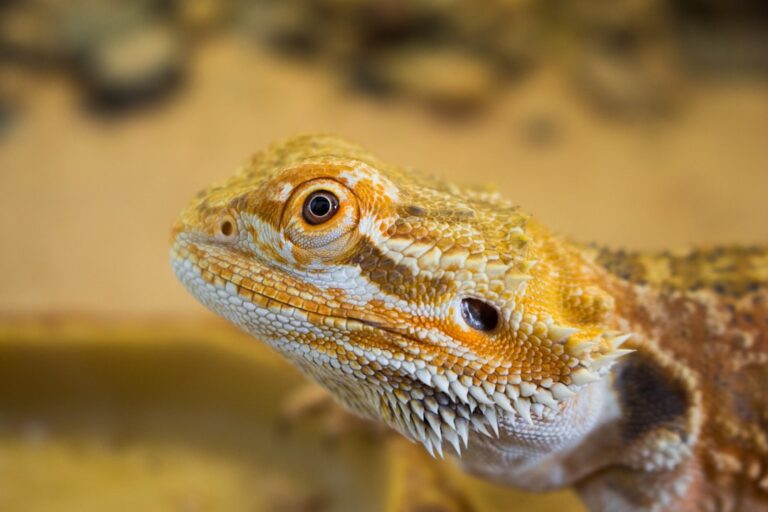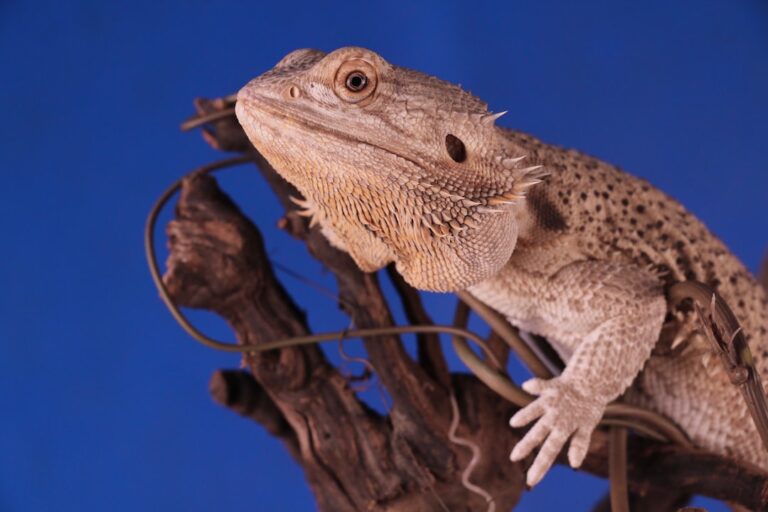Are Bearded Dragons Blind?
Bearded dragons are fascinating reptiles that have become popular pets in recent years. These unique creatures have their own set of characteristics and behaviors, including their vision. Understanding how bearded dragons see is important for their overall well-being and care. In this article, we will explore the myths and facts surrounding bearded dragon vision, the anatomy of their eyes, their eyesight capabilities, how they perceive color and contrast, common eye problems they may encounter, and how to care for a blind bearded dragon.
Table of Contents
Understanding Bearded Dragon Vision: Myths and Facts
There are several common myths about bearded dragon vision that need to be debunked. One myth is that they can see in the dark. While bearded dragons have good low-light vision, they are not able to see in complete darkness. Another myth is that they can see through glass. In reality, bearded dragons cannot see through glass and may become stressed or confused when trying to interact with their reflection.
On the other hand, there are also facts about bearded dragon vision that are important to know. Bearded dragons have a wide field of view due to the placement of their eyes on the sides of their head. They also have a third eye called the parietal eye, which is located on the top of their head and helps them detect changes in light intensity and movement.
The Anatomy of Bearded Dragon Eyes
To understand how bearded dragons see, it is essential to understand the structure and function of their eyes. Bearded dragons have large, round eyes with a horizontal pupil. This shape allows them to have a wide field of view and better depth perception.
The different parts of a bearded dragon’s eye include the cornea, iris, lens, retina, and optic nerve. The cornea is the clear outer layer that protects the eye and helps focus light onto the retina. The iris controls the size of the pupil, which regulates the amount of light entering the eye. The lens focuses light onto the retina, which contains specialized cells called photoreceptors that detect light and send signals to the brain through the optic nerve.
Do Bearded Dragons Have Good Eyesight?
When comparing bearded dragon eyesight to human eyesight, there are some notable differences. Bearded dragons have better peripheral vision than humans due to the placement of their eyes on the sides of their head. However, their visual acuity is not as sharp as humans, meaning they may not be able to see fine details as clearly.
Several factors can affect a bearded dragon’s eyesight. One factor is their age, as younger bearded dragons may have better eyesight than older ones. Another factor is their overall health, as poor nutrition or illness can impact their vision. Additionally, environmental factors such as lighting and temperature can also affect their eyesight.
How Bearded Dragons See Color and Contrast
Bearded dragons have color vision, but it is not as vibrant as that of humans. They are able to see a range of colors, but they may not perceive them in the same way we do. For example, they may not be able to distinguish between certain shades or hues.
Contrast vision is also important for bearded dragons. They are more sensitive to contrast than humans, which helps them detect movement and changes in their environment. This sensitivity to contrast is beneficial for hunting prey and avoiding predators in the wild.
Vision Impairment in Bearded Dragons: Causes and Symptoms
There are several common causes of vision impairment in bearded dragons. One cause is eye infections, which can lead to inflammation and damage to the eye tissues. Another cause is injury or trauma to the eye, such as scratches or foreign objects getting lodged in the eye.
Symptoms of vision impairment in bearded dragons can vary but may include redness, swelling, discharge, cloudiness, or changes in behavior. If you notice any of these symptoms, it is important to seek veterinary care for your bearded dragon as soon as possible.
Common Eye Problems in Bearded Dragons
There are several common eye problems that bearded dragons may experience. One common problem is conjunctivitis, which is an inflammation of the conjunctiva, the thin membrane that covers the front of the eye. Conjunctivitis can be caused by bacterial or viral infections, as well as irritants or injuries.
Another common eye problem is corneal ulcers, which are open sores on the cornea. Corneal ulcers can be caused by scratches or foreign objects in the eye and can lead to pain, redness, and discharge.
Other eye problems that bearded dragons may encounter include cataracts, glaucoma, and retinal detachment. Each of these conditions can cause vision impairment and require veterinary treatment.
How to Prevent Eye Injuries in Bearded Dragons
Preventing eye injuries in bearded dragons is essential for maintaining their overall eye health. One tip is to provide a safe and appropriate enclosure for your bearded dragon. This includes using a tank or enclosure with secure lids to prevent escapes and potential injuries.
Another tip is to avoid placing objects with sharp edges or small parts in the enclosure that could potentially harm your bearded dragon’s eyes. It is also important to regularly clean and disinfect the enclosure to prevent the buildup of bacteria or irritants that could lead to eye infections.
Caring for a Blind Bearded Dragon
If your bearded dragon becomes blind due to an eye condition or injury, it is still possible to provide them with a good quality of life. One important aspect of caring for a blind bearded dragon is to create a consistent and predictable environment for them. This includes keeping their enclosure layout and furnishings the same to help them navigate their surroundings.
You can also provide tactile cues for your blind bearded dragon by placing objects with different textures in their enclosure. This can help them navigate and explore their environment using their sense of touch.
Training Blind Bearded Dragons: Tips and Tricks
Training a blind bearded dragon may require some additional patience and creativity, but it is possible. One tip is to use auditory cues to communicate with your blind bearded dragon. You can use a specific sound or word to signal feeding time or other activities.
Another tip is to use positive reinforcement training techniques, such as clicker training, to teach your blind bearded dragon new behaviors. By associating a clicker sound with a reward, you can effectively communicate with your blind bearded dragon and reinforce desired behaviors.
Bearded Dragons Can See, but They Have Their Limitations
In conclusion, understanding bearded dragon vision is crucial for their overall care and well-being. While they may not have the same visual capabilities as humans, they are still able to see and perceive their environment in their own unique way. By debunking myths, understanding the anatomy of their eyes, recognizing common eye problems, and learning how to care for blind bearded dragons, we can provide the best possible care for these fascinating reptiles.
If you’re interested in learning more about reptiles and their unique behaviors, you might want to check out this article on do iguanas blink? It delves into the fascinating world of iguanas and explores whether or not they have the ability to blink their eyes. Just like bearded dragons, iguanas are captivating creatures with their own set of intriguing characteristics. So, if you’re curious about reptile behavior, this article is definitely worth a read!







